The young man looked at me distrustfully. I gestured to him
to head across the pedestrian crossing where I’d stopped my bike for him. He
again looked warily to his left, in the direction from which cars tear at high
speed down Hoyt Street ,
in Cobble Hill, in defiance of the area’s 20mph speed limit. Having finally
decided that it was safe, he crossed and I was able to resume my journey.
The incident on Friday night was one of the clearest illustrations I’ve encountered recently of the difficulty of communicating with other
road users. Such communications are often obstructed by noise, by the challenges
of communicating with people inside a metal box and by people’s varying
expectations about how other road users will behave. The young man I
encountered was fearful of my effort to help him cross the road precisely because
no-one else stops for that crosswalk, which links shops on Hoyt St to the
Gowanus Houses public housing on the other side of the road. My stopping was so
out of step with other road users’ behaviour that it must have seemed like some
kind of practical joke.
The communication barrier facing cyclists seems particuarly high in cities like New York and London where cars dominate the streetscape . In such big, industrialised cities with only modest cycling levels, few other road users have the inbuilt sense of how cyclists might or
should behave that they have with motorists and pedestrians. The scope for severe mutual misunderstanding is significant.
Yet roads remain intensely communal places, where the
different users are entirely reliant on each other for safety. Cyclists,
drivers and pedestrians all need to decode a complex series of verbal and
non-verbal signals to work out each others’ intentions and likely future
behaviour. The communication barriers play a big part in ensuring that roads remain such dangerous places. But almost no-one addresses the obstacles that the obvious and growing barriers represent.
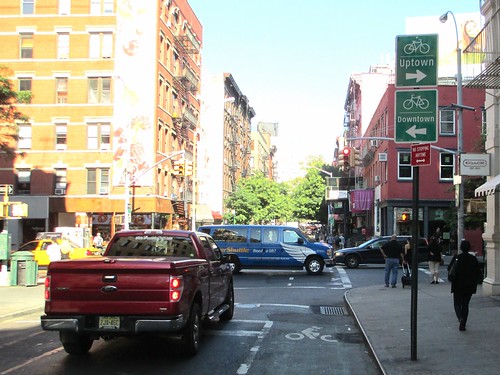 |
| Prince St at W Broadway, Manhattan: a venue where I often have to practise my new communication policy with drivers. |
My sensitivity to the challenges of interacting with other
road users has been heightened, I suspect, by a change in my own communication
policy. In the last few months, I’ve become even more prone than before to
using my loud, powerful voice to try to stop drivers from running me over. I do
this most often by shouting at drivers trying to cut across my path at
intersections, “Stop! Wait there!” While I’m sure that many of those at whom I shout have no
desire to behave legally and respect my right of way, most drivers who hear someone shout, “Stop!” loudly in their direction seem to step at least temporarily on the brake pedal.
But I’ve also been struck by the policy’s shortcomings. It
regularly leads passersby to shout mockingly at me, rather as though vocal
communications in traffic were subject to the same taboos as speaking in a
library or an ancient sacred space. People seem to resent clear, unambiguous
communication across the cyclist-driver divide.
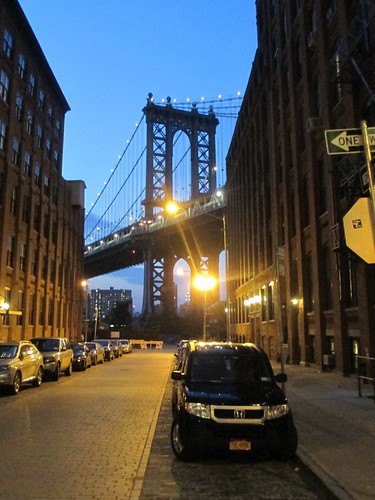 |
| Pearl St, in Dumbo: good luck communicating clearly with the driver if one of those cars starts pulling out in front of your bike. |
My shouts also seem to work far less well with drivers
who are pulling out of parking spaces into my path. There’s a tendency for
drivers creeping slowly into a bike lane while waiting for a suitable gap to
pull out to believe their intentions should be clear to those around them. When
I shout, “Stop!” at such a driver moving slowly into my path, his or her
rejoinder is often to shout, “I saw you!” There’s a failure on the driver’s
part to understand that his or her actions communicate the intention to pull
out but not that he or she has seen me and is taking care not to hit me.
It’s because I recognise that my actions are my clearest
means of communicating with fellow road-users that I seek, by and large, to
obey traffic signals. I hope – and I realise it’s a fairly forlorn hope – that
the example of my self-discipline will communicate itself to the drivers who pose the real danger. I think there’s a usefulness to having an agreed set of standards for
how to act on the roads – albeit a severely flawed one – and to making a point
of obeying it.
For the same reason, I try as I cycle around to make obvious, unambiguous movements.
When passing a car parked in a bike lane, I don’t squeeze by hoping that other
vehicles won’t pass me too close. I swing firmly out into the neighbouring
traffic lane, showing following motorists that they shouldn’t overtake. I try
to make eye contact with drivers when I can. I signal clearly where I’m going.
I use my bell to warn pedestrians when I’m approaching – although, frankly, a
follow-up shout of “Watch out in the crosswalk!” to people crossing against the
light is generally necessary.
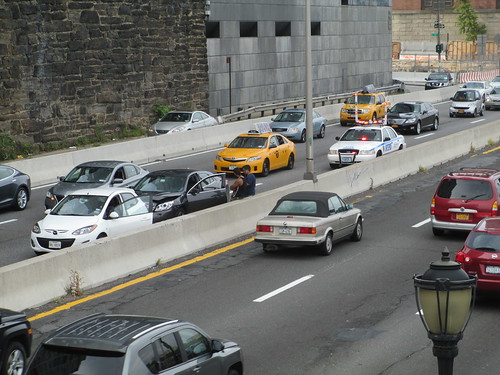 |
| A rear-end shunt on FDR Drive: looked at another way, it's a failure of two drivers to communicate clearly |
Many of these efforts nevertheless run slap-bang into vast barriers. Some of them are cultural. New York drivers seem so used to the idea that they can pass a cyclist in a bike lane with only a tiny space to spare that it barely seems worth trying to communicate with those who do why their behaviour is so dangerous. I ran into similar challenges when I lived in London with drivers who simply didn't seem to realise they shouldn't block advance stop boxes at traffic lights.
The most inescapable fact of on-road communication, meanwhile, is that the modern motor vehicle is designed to shield users from the reality of their being involved in a social interaction. The interior of a motor car looks and feels more like someone’s home than a machine for transporting goods and people. Cadillac last year ran an advertising campaign showing a ring of cymbal-clanging toy monkeys surrounding a Cadillac CTS expressly to boast how the vehicle’s sound-proofing, glass and even noise-cancelling equipment would silence the reality outside the vehicle. It’s no surprise that people riding in such vehicles might struggle to grasp the complexity of what’s going on in the streets surrounding them – or that they might react angrily to my rapping on the window to point out that they’ve nearly, by their negligence, run me off the road.
The most inescapable fact of on-road communication, meanwhile, is that the modern motor vehicle is designed to shield users from the reality of their being involved in a social interaction. The interior of a motor car looks and feels more like someone’s home than a machine for transporting goods and people. Cadillac last year ran an advertising campaign showing a ring of cymbal-clanging toy monkeys surrounding a Cadillac CTS expressly to boast how the vehicle’s sound-proofing, glass and even noise-cancelling equipment would silence the reality outside the vehicle. It’s no surprise that people riding in such vehicles might struggle to grasp the complexity of what’s going on in the streets surrounding them – or that they might react angrily to my rapping on the window to point out that they’ve nearly, by their negligence, run me off the road.
Inside that sensation-deprived space, there must be a heightened sense of frustration at the mismatch between the
calm sounds of the vehicle’s clear stereo or white noise and the more chaotic
pictures coming in through the windows. I’m confident that frustration explains
many of the times I have motorists drive fast at me, blaring their horns. This
silent, frantically pedalling cyclist must seem like a disorderly intrusion
compared with the orderly sound world of the vehicle’s interior.
All of these obstacles play a part in keeping New York's road safety record poor, despite the current mayor's Vision Zero efforts. The position would, needless to say, grow easier if the city built more infrastructure to reduce conflicts, including more of a network of well-designed protected cycle paths.
All of these obstacles play a part in keeping New York's road safety record poor, despite the current mayor's Vision Zero efforts. The position would, needless to say, grow easier if the city built more infrastructure to reduce conflicts, including more of a network of well-designed protected cycle paths.
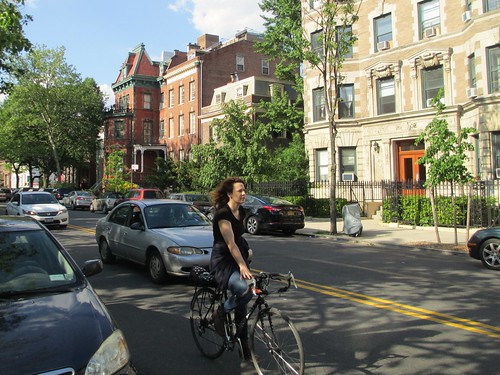 |
| A driver overtakes a cyclist: one of these people is in a box sound-proofed to ensure he can ignore the other. |
As it stands, people find themselves caught up in conflicts fuelled by misunderstanding - and seized of a powerful impulse to reach
through the barriers and explain why they're frustrated. I saw it vividly one recent
morning when a woman, wrapped up in her car’s smooth inner world, pulled out of
a side street in front of a cyclist careering down Smith St on a single speed. The cyclist
jammed on his brakes and landed in a heap. His immediate instinct was to spring
to his feet and aim a defiant one-fingered salute towards the rear-view mirror
of the motorist. I suspect she never had any inkling of the harm she had done.
I was caught up in a more complicated instance last
Thursday when cycling home down Grand St in SoHo .
A man in front of me was pushing a baby buggy (stroller, American readers) down
the narrow bike lane, one child inside the stroller and another riding on the
rear. His only reaction to my bell-ringing was to continue an exaggerated
saunter, taking obvious pleasure in blocking my way.
It wasn't the first time I'd come across people deliberately blocking the lane on Grand St to prevent cyclists' using it. I've long since tired of giving people who deliberately obstruct me the tolerance I generally extend to even inattentive pedestrians. My irritation welled up when he turned to me at an intersection and sneered, “But we’ve got wheels. We’re allowed to use it.”
It wasn't the first time I'd come across people deliberately blocking the lane on Grand St to prevent cyclists' using it. I've long since tired of giving people who deliberately obstruct me the tolerance I generally extend to even inattentive pedestrians. My irritation welled up when he turned to me at an intersection and sneered, “But we’ve got wheels. We’re allowed to use it.”
I started calmly, pointing out that it was irresponsible of
him to block a busy bike lane and that someone could have hit him. It would
have been irresponsible of me to hit him, he replied, so I was the
irresponsible one. His deliberate, bullying contempt mixed in with my
tiredness after a red-eye flight the night before and my dismay at the emerging
British general election results. I felt the urge to communicate quite how
deeply he had offended me.
I pointed out – accurately, I think – that he was setting a poor example to his children. I pointed out – again accurately – that his
behaviour was making his wife slink away in embarrassment. I finished with a piece of more metaphysical speculation.
“Your soul’s shrivelling inside you because you’re so petty,” I shouted as I rode away.
“Your soul’s shrivelling inside you because you’re so petty,” I shouted as I rode away.
I should not, clearly, have allowed myself to be provoked. But humans feel the need to connect and communicate with those around them. Far too many street and vehicle designs hinder, rather
than work with, humans’ need to talk to each other. It feels like no exaggeration to say that's drying up many cities' souls.
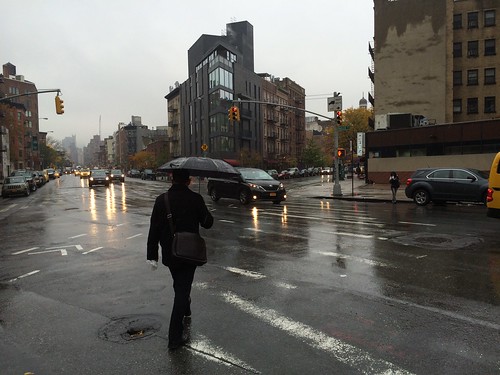
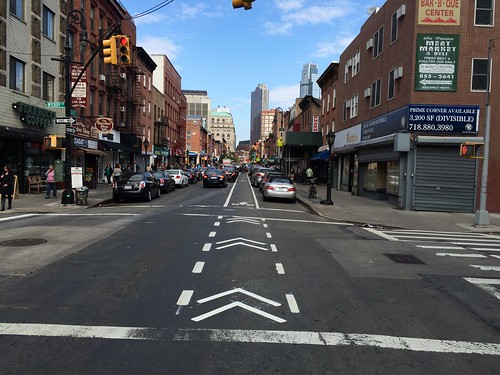
You may want to express yourself to motor vehicle operators, but it's likely that their no. 1 message to you is, "Get out of my way." I don't think you are adequately taking power imbalances into account.
ReplyDeleteJonathan,
DeleteThanks for the comment.
I recognise there are very severe imbalances of power. That's part of what is interesting about the situation. It's precisely to preserve the imbalance of power that motorists are so keen on vehicles that shield them from the outside world. But one can't explore every aspect of every issue in every blogpost.
All the best,
Invisible.
Strollers are definitely not bicycles by legal definition:
ReplyDeleteS 102. Bicycle. Every two or three wheeled device upon which a person or persons may ride, propelled by human power through a belt, a chain or gears, with such wheels in a tandem or tricycle, except that it shall not include such a device having solid tires and intended for use only on a sidewalk by pre-teenage children.
S 102-a. Bicycle lane. A portion of the roadway which has been designated by striping, signing and pavement markings for the preferential or exclusive use of bicycles.
Anonymous,
DeleteThanks for the comment.
I don't for a moment think this guy seriously thought he had a right to be there. He was just trying to be unpleasant and obstructive - an attempt in which he was triumphantly succeeding.
All the best,
Invisible.
"The interior of a motor car looks and feels more like someone’s home than a machine for transporting goods and people. ... It’s no surprise that ... they might react angrily to my rapping on the window"
ReplyDeleteWhich is why I've given up doing that. The adrenaline rush in avoiding a badly driven car followed by the perceived aggression and invasion of personal space by banging on the drivers window, bar a couple of notable exceptions, never lead to the most beneficial discussions on road etiquette and would ruin the rest of my journey/day while I seethed over the interaction (in fact just thinking about them now provokes the same reaction).
Now I aim to think 'what an idiot' and just carry on and generally forget about them.
"I hope – and I realise it’s a fairly forlorn hope – that the example of my self-discipline in waiting at red traffic lights on quiet streets will communicate itself to the drivers"
I've given up doing that as well & it certainly makes ignoring poor driver behaviour easier as it removes the initial self-righteous thought "Hey, I'm a fricking beacon of virtue here & you still behave like that! I'm going to call you to account & show you the error of your ways."
So instead of waiting patiently at lights, if there is a rubbish shared use path alongside I'll hop onto that past the lights & then back onto the road, etc.
It'll be fine until I snap. ;)
T,
DeleteI don't often knock on drivers' windows. But I am struck by the mutual incomprehension on the rare occasions that I do. I last did it several weeks ago with a woman who was texting while driving in midtown Manhattan. I asked her if she'd seen me before moving her car as I passed. She said yes. I asked her which side I'd passed her car. She grew aggressive. I have had some constructive conversations as a result of these communications. There haven't been many, however. It possibly helps that I don't swear, albeit I do quite often shout.
As for the skipping lights thing, one issue in New York is that the NYPD love to hand out tickets (costing $200 or more each) to cyclists they spot skipping lights. I'm desperate not to get hit with one of those.
All the best,
Invisible.
Trying to make eye contact is fine, but you strike me as entirely too smart to count on it as a reliable guide. I find the motor vehicle wheels as my main guide to what the vehicle is up to.
ReplyDeleteSteve,
DeleteThanks for the comment, as always. I mention the eye contact because, firstly, this piece is about communication and it seems a little beside the point to mention how long I spend staring at vehicles' wheel arches. Secondly, I do make eye contact with drivers when sitting at traffic lights and so forth, at the point where such human contact might help to make things go better and when there isn't really much else useful to do.
But your supposition is correct - I spend a lot of time looking very carefully at vehicles' wheels. That's why I so often spot that vehicles are creeping out into my path.
All the best,
Invisible.
I did not read your entire post so sorry if I address something you addressed or veer too far off topic.
ReplyDeleteMostly I interact with cars as a pedestrian (when I'm not driving myself, of course.) I interact as a militant pedestrian. That is I not only try to insist on my own legal rights but I am also not shy about ignoring the law and acting what I consider rationally. As a pedestrian it would be extremely difficult to accidentally maim or kill someone when I do so. So yes my ignoring a red light is quite different than a car ignoring a red light. I mention this not to promote it but to give you insight into my relationship with cars as a pedestrian.
Communicating with cars is of course very important to one who is defending their rights. Two days ago while on a walk I experienced a miscommunication. In my Chicago neighborhood there have appeared in the middle of small arterial streets (a single car driving lane in each direction and center striping) signs at marked crosswalks (wide international strips parallel with the street) reminding drivers that pedestrians in the crosswalk have the right-of-way. The right exists as well where there are no signs nor painted indications of a crosswalk or the perhaps the two line crosswalk paint from one side of the street to the other. At any of these crosswalks I am more than comfortable at putting my hand up stiff arm with palm out towards the driver in the universal signal to stop. And if need be I will point to the driver specifically with my other hand. Always only if I have given the driver enough time to safely stop.
That is what I mean by militant pedestrian. I see myself doing duty as a feature of traffic calming.
But there is another me the jaywalking pedestrian. I fully recognize that I have no legal right to the road at that place and/or time. Such a me assumes that a car will do the worst thing relative to me because of whatever. Sort of like biking I guess. I am sharing the roadway when jaywalking. Since I am looking for the moments where I do not interfere at all with the forward progress of the drivers I assume that I am being politic if not polite.
So two days ago I was out for a walk, exercise style which means a fast clip. In thought I approached the afore-mentioned cross-walk and without thinking began to cross it jaywalk style. That is to say in such a way as to not inconvenience the drivers. Even though I had the right of way. So I was angling my path to walk behind the oncoming car after they had passed. Again as jaywalker I rarely attempt to communicate with a driver. And generally driver's get it.
But this oncoming driver hit the brakes with a bit of a screech and came to a clean controlled stop with plenty of room for me to continue on. The sign in the middle of the street (number six after its cousins had be run over and shredded) was now starting to show results. Drivers there are now on some kind of alert and are more ready to stop.
But I still felt a little bad. Proper body communication would have had me enter the crosswalk, establish that I saw them coming and could recognize that they could and would stop, and then proceed. Instead I was giving out the Jaywalking signals which did not register to them.
Lastly I want to say, loud air driven bike horns. For those times when nothing says it clearer to drivers.